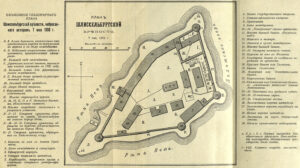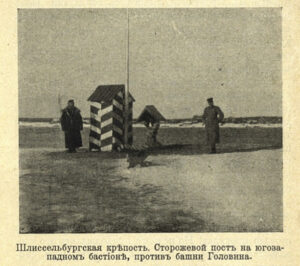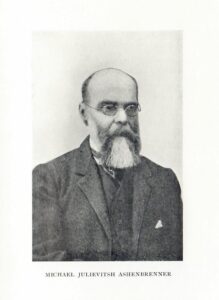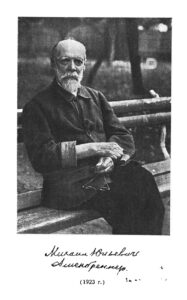Illustrating memoirs
The English translation of Ivan Iuvachev’s memoir/history of Shlissel’burg Fortress is now available on this website. Iuvachev – father of the absurdist writer Daniil Kharms – was originally sentenced to death, commuted to 15 years’ hard labour. However, after three years’ incarceration in Shlissel’burg, and suffering from mental illness (other memoirs describe this as ‘religious mania’), he was transferred to exile-settlement on Sakhalin Island (about which he also wrote an important memoir). He was the only prisoner to benefit from this sort of largesse. It gives his memoir an interesting distance that enables him to record the history of imprisonment at the fortress as well as his own experiences there.
Not for the first time, I was initially confused by the early 20th-century spelling ‘Youvatshev’, and was very slow to connect The Russian Bastille with Iuvachev’s Shlissel’burgskaia krepost’. Once I’d realized that the former was a translation of the latter, it struck me that one reason I’d failed to make the connection more quickly was the different illustrations the two versions use.

The original publication primarily uses images of the fortress. There are 15 photographs of Shlissel’burg itself, alongside three plans of the fortress and new prison, plus one picture of the Peter and Paul Fortress in St Petersburg. There are only seven of pictures of people: five of prisoners, one of Princess Maria Mikhailovna Dondukova-Korsakova, who was allowed to visit the remaining Shlissel’burg inmates in the last couple of years of their sentences, and one of an apocryphal (?) meeting between Tsar Peter III and deposed emperor Ioann Antonovich.

By contrast, the translation features only three photographs of the fortress, and has 13 of people – including the same pictures of Ioann Antonovich and of Princess Dondukova-Korsakova, and nine portraits of prisoners, although not, curiously, of the author himself.
I think this difference has a significant influence on the formal coherence of the two versions, and how we read them. I interpreted the Russian version as a biography of place. There’s a strong sense of representing the prisoners through the spaces of the prison. Iuvachev’s detailed description of who occupied which cells is accompanied by plans of the new prison that concretize the people relative to their spatial arrangement, making the prisoners part of the place. When the author shifts from his own experience to examining the carceral history of Shlissel’burg, it places the revolutionary inmates in the wider context, bringing the palimpsest of the prison to life. And Iuvachev’s description of his return to the fortress in 1906 to take a guided tour reduces his own distance – as the first prisoner to be removed from the prison – from the events and places he has been describing. In the translation, on the other hand, the same description of the distribution of prisoners, in the absence of the plans, feels more abstract, and less connected to the subsequent turn to the fortress’s history. In other words, the change to the images – possibly undertaken in an attempt to bring the personalities of the prisoners more to life – has the unfortunate side-effect of undermining Iuvachev’s efforts to make his revolutionary comrades part of the fortress’s history and topography.

One other oddity of the illustrations in both versions is that the portrait that purports to be of Mikhail Ashenbrenner is clearly no such thing. This is Ashenbrenner, from his Voennaia organizatsiia Narodnoi voli i drugie vospominaniia (1860-1904):

It’s a curious mistake to make, given that Iuvachev describes in detail meeting Ashenbrenner after the latter’s release. As in my previous post, this contributes to a sense of confusion about who the Shlissel’burg prisoners were, and is a sign that the Tsarist authorities’ attempts to erase their names from memory – about which Ashenbrenner wrote in his memoir (Writing Resistance, pp. 108-9) – were at least partially successful. Meanwhile, if anyone can identify the man in the picture, please let me know!
Works cited
Iuvachev, I. P. Shlisselʹburgskaia krepostʹ. Izdatelʹstvo ‘Posrednik’, 1907, http://dlib.rsl.ru/viewer/01003745902#?page=5.
Youvatshev, I. P. The Russian Bastille, or the Schluesselburg Fortress. Translated by A. S. Rappoport, Chatto & Windus, 1909, https://archive.org/details/russianbastilleo00iuvarich/mode/2up.